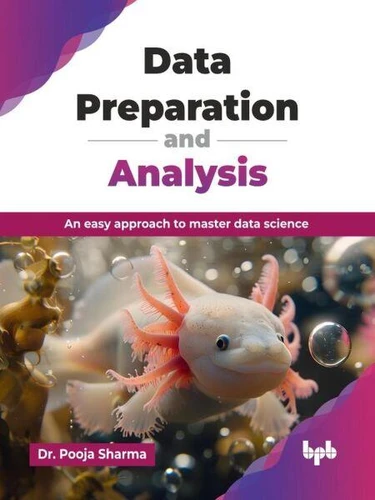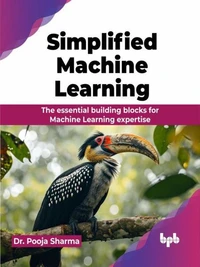Nouveauté
Data Preparation and Analysis: An easy approach to master data science
Par :Formats :
Disponible dans votre compte client Decitre ou Furet du Nord dès validation de votre commande. Le format ePub protégé est :
- Compatible avec une lecture sur My Vivlio (smartphone, tablette, ordinateur)
- Compatible avec une lecture sur liseuses Vivlio
- Pour les liseuses autres que Vivlio, vous devez utiliser le logiciel Adobe Digital Edition. Non compatible avec la lecture sur les liseuses Kindle, Remarkable et Sony
- Non compatible avec un achat hors France métropolitaine
 , qui est-ce ?
, qui est-ce ?Notre partenaire de plateforme de lecture numérique où vous retrouverez l'ensemble de vos ebooks gratuitement
Pour en savoir plus sur nos ebooks, consultez notre aide en ligne ici
- FormatePub
- ISBN978-93-6589-174-4
- EAN9789365891744
- Date de parution11/08/2025
- Protection num.Adobe DRM
- Infos supplémentairesepub
- ÉditeurBPB Publications
Résumé
DESCRIPTION Data science is an evolving field, and the ability to effectively prepare and analyze data is a critical skill for any aspiring professional. This book serves as a comprehensive introduction to the foundational concepts and tools of data science, making it ideal for beginners and aspiring data professionals. This book provides a structured and comprehensive learning path, beginning with a broad introduction to data science, its applications, and fundamental analysis methods.
You will then explore the core Python libraries for data manipulation, NumPy for efficient numerical operations, and Pandas for powerful data structuring and transformation. The book dedicates significant focus to real-world data challenges, walking you through the crucial steps of data gathering, preparation, and cleaning; addressing issues like scalability, missing data, and inconsistencies. The book concludes with three real-world projects that apply the concepts in practical settings, making you proficient in the entire end-to-end data preparation and analysis pipeline.
You will have a solid command of essential tools and techniques, empowering you to confidently tackle and derive meaningful insights from diverse datasets in any professional setting. WHAT YOU WILL LEARN? Implement ML models using NumPy, Pandas, Matplotlib, or scikit-learn.? Gain a solid foundation in data science, principles, algorithms, and methodologies.? Learn to frame real-world problems as ML tasks. ? Implement data cleaning for consistency and missing data.? Conduct exploratory data analysis with descriptive statistics.? Uncover data patterns using clustering and association techniques.? Design and create effective time series visualizations.? Build interactive visualizations to explore data.? Apply an end-to-end data workflow in practical projects.
WHO THIS BOOK IS FORThis book is ideal for students, programmers, and software engineers who want to learn data science from scratch. It assumes basic programming proficiency, but no prior data science knowledge is required to follow the comprehensive, hands-on curriculum.
You will then explore the core Python libraries for data manipulation, NumPy for efficient numerical operations, and Pandas for powerful data structuring and transformation. The book dedicates significant focus to real-world data challenges, walking you through the crucial steps of data gathering, preparation, and cleaning; addressing issues like scalability, missing data, and inconsistencies. The book concludes with three real-world projects that apply the concepts in practical settings, making you proficient in the entire end-to-end data preparation and analysis pipeline.
You will have a solid command of essential tools and techniques, empowering you to confidently tackle and derive meaningful insights from diverse datasets in any professional setting. WHAT YOU WILL LEARN? Implement ML models using NumPy, Pandas, Matplotlib, or scikit-learn.? Gain a solid foundation in data science, principles, algorithms, and methodologies.? Learn to frame real-world problems as ML tasks. ? Implement data cleaning for consistency and missing data.? Conduct exploratory data analysis with descriptive statistics.? Uncover data patterns using clustering and association techniques.? Design and create effective time series visualizations.? Build interactive visualizations to explore data.? Apply an end-to-end data workflow in practical projects.
WHO THIS BOOK IS FORThis book is ideal for students, programmers, and software engineers who want to learn data science from scratch. It assumes basic programming proficiency, but no prior data science knowledge is required to follow the comprehensive, hands-on curriculum.
DESCRIPTION Data science is an evolving field, and the ability to effectively prepare and analyze data is a critical skill for any aspiring professional. This book serves as a comprehensive introduction to the foundational concepts and tools of data science, making it ideal for beginners and aspiring data professionals. This book provides a structured and comprehensive learning path, beginning with a broad introduction to data science, its applications, and fundamental analysis methods.
You will then explore the core Python libraries for data manipulation, NumPy for efficient numerical operations, and Pandas for powerful data structuring and transformation. The book dedicates significant focus to real-world data challenges, walking you through the crucial steps of data gathering, preparation, and cleaning; addressing issues like scalability, missing data, and inconsistencies. The book concludes with three real-world projects that apply the concepts in practical settings, making you proficient in the entire end-to-end data preparation and analysis pipeline.
You will have a solid command of essential tools and techniques, empowering you to confidently tackle and derive meaningful insights from diverse datasets in any professional setting. WHAT YOU WILL LEARN? Implement ML models using NumPy, Pandas, Matplotlib, or scikit-learn.? Gain a solid foundation in data science, principles, algorithms, and methodologies.? Learn to frame real-world problems as ML tasks. ? Implement data cleaning for consistency and missing data.? Conduct exploratory data analysis with descriptive statistics.? Uncover data patterns using clustering and association techniques.? Design and create effective time series visualizations.? Build interactive visualizations to explore data.? Apply an end-to-end data workflow in practical projects.
WHO THIS BOOK IS FORThis book is ideal for students, programmers, and software engineers who want to learn data science from scratch. It assumes basic programming proficiency, but no prior data science knowledge is required to follow the comprehensive, hands-on curriculum.
You will then explore the core Python libraries for data manipulation, NumPy for efficient numerical operations, and Pandas for powerful data structuring and transformation. The book dedicates significant focus to real-world data challenges, walking you through the crucial steps of data gathering, preparation, and cleaning; addressing issues like scalability, missing data, and inconsistencies. The book concludes with three real-world projects that apply the concepts in practical settings, making you proficient in the entire end-to-end data preparation and analysis pipeline.
You will have a solid command of essential tools and techniques, empowering you to confidently tackle and derive meaningful insights from diverse datasets in any professional setting. WHAT YOU WILL LEARN? Implement ML models using NumPy, Pandas, Matplotlib, or scikit-learn.? Gain a solid foundation in data science, principles, algorithms, and methodologies.? Learn to frame real-world problems as ML tasks. ? Implement data cleaning for consistency and missing data.? Conduct exploratory data analysis with descriptive statistics.? Uncover data patterns using clustering and association techniques.? Design and create effective time series visualizations.? Build interactive visualizations to explore data.? Apply an end-to-end data workflow in practical projects.
WHO THIS BOOK IS FORThis book is ideal for students, programmers, and software engineers who want to learn data science from scratch. It assumes basic programming proficiency, but no prior data science knowledge is required to follow the comprehensive, hands-on curriculum.




